UWA macro, Relay lens for CCTV fisheye - vignetting problem
Moderators: rjlittlefield, ChrisR, Chris S., Pau
UWA macro, Relay lens for CCTV fisheye - vignetting problem
Dear all,
here's another newbie who found you googling for info on relay lenses.
I'd like to make a setup for ultra-wide-angle "deep focus" "bug's eye" "panoramic" macro for APS-C crop sensor camera (Nikon D90). Some references first:
http://www.pbase.com/kds315/relay_lens_systems&page=all
http://www.flickr.com/groups/science-is ... 113509357/
http://www.visual-innovations.zoomshare.com/0.html
http://antfarm.yuku.com/topic/4178/t/Th ... photo.html
http://www.koheisha.net/microwidelenz/m ... aps01.html
http://www.panavision.com/content/spherical-specialty
http://www.panavision.co.uk/pdf/downloa ... -sheet.pdf
http://amzn.com/2880467829 (page 87)
ES http://www.amazon.co.uk/dp/0557925371 (page 539)
BR http://www.naturfotograf.com/roll_your_own_lens.html
I've got a Sunex CCTV fisheye DSL-227 to play with (not the best choice because of fixed aperture), "board lens" with a C-mount adapter, with image circle 5 or 6 mm, so I think I need a 3x to 4x relay.
I'd prefer to have a short compact setup like those described by ES and BR... but preferably without using expensive specialty lenses (Photar 25mm f/2, Macro-Nikkor 19mm f/2.8 ) .
The problem is I've tried a dozen of one-to-three-element relay attempts using gear at hand, all of which tend to produce useful magnification without vignetting when used alone, but vignette more or less heavily with the fisheye added. In some cases the viewfinder image looks quite acceptable, but live view and actual images are awful.
Gear at hand: Nikkor 50/1.8D, 18-200VR, 20/3.5 AIS, a scrap 18-55 with a broken mount, Tamron 60/2 macro, Vivitar 2x macro focusing TC, Kenko and C-mount extension tubes, some adapters.
Best results so far using the Tamron 60 with the set of extension tubes or the macro TC; vignetting only slight, but a bit less magnification than desired.
I was hoping the reversed 20mm would do the trick, as vaguely suggested by BR... is the problem in the smaller max aperture (f/3.5)? Or am I doing something wrong? I did notice that stopping down the relay lens generally does make things worse.
In case this may give any clue, I got a bad example of relay vignetting not with the CCTV fisheye but in an opposite exercise when I tried to convert the 20mm (FX lens, so oversized image circle on a DX crop camera) to about 14mm on DX, by using a relay with 1/1.5 magnification (like in the simplified Frazier lens) implemented with the Tamron 60 macro.
here's another newbie who found you googling for info on relay lenses.
I'd like to make a setup for ultra-wide-angle "deep focus" "bug's eye" "panoramic" macro for APS-C crop sensor camera (Nikon D90). Some references first:
http://www.pbase.com/kds315/relay_lens_systems&page=all
http://www.flickr.com/groups/science-is ... 113509357/
http://www.visual-innovations.zoomshare.com/0.html
http://antfarm.yuku.com/topic/4178/t/Th ... photo.html
http://www.koheisha.net/microwidelenz/m ... aps01.html
http://www.panavision.com/content/spherical-specialty
http://www.panavision.co.uk/pdf/downloa ... -sheet.pdf
http://amzn.com/2880467829 (page 87)
ES http://www.amazon.co.uk/dp/0557925371 (page 539)
BR http://www.naturfotograf.com/roll_your_own_lens.html
I've got a Sunex CCTV fisheye DSL-227 to play with (not the best choice because of fixed aperture), "board lens" with a C-mount adapter, with image circle 5 or 6 mm, so I think I need a 3x to 4x relay.
I'd prefer to have a short compact setup like those described by ES and BR... but preferably without using expensive specialty lenses (Photar 25mm f/2, Macro-Nikkor 19mm f/2.8 ) .
The problem is I've tried a dozen of one-to-three-element relay attempts using gear at hand, all of which tend to produce useful magnification without vignetting when used alone, but vignette more or less heavily with the fisheye added. In some cases the viewfinder image looks quite acceptable, but live view and actual images are awful.
Gear at hand: Nikkor 50/1.8D, 18-200VR, 20/3.5 AIS, a scrap 18-55 with a broken mount, Tamron 60/2 macro, Vivitar 2x macro focusing TC, Kenko and C-mount extension tubes, some adapters.
Best results so far using the Tamron 60 with the set of extension tubes or the macro TC; vignetting only slight, but a bit less magnification than desired.
I was hoping the reversed 20mm would do the trick, as vaguely suggested by BR... is the problem in the smaller max aperture (f/3.5)? Or am I doing something wrong? I did notice that stopping down the relay lens generally does make things worse.
In case this may give any clue, I got a bad example of relay vignetting not with the CCTV fisheye but in an opposite exercise when I tried to convert the 20mm (FX lens, so oversized image circle on a DX crop camera) to about 14mm on DX, by using a relay with 1/1.5 magnification (like in the simplified Frazier lens) implemented with the Tamron 60 macro.
- Charles Krebs
- Posts: 5865
- Joined: Tue Aug 01, 2006 8:02 pm
- Location: Issaquah, WA USA
- Contact:
While I don't have an answer to your specific application, when setting up various "relay" optics on a microscope, vignetting is often due to an inability to get a good fit (physically "close enough") for the exit pupil of the primary optic and the entrance pupil of the "relay".
I've never worked with a "board lens". I think(?) they sometimes have a very short physical distance from the rear of the lens to the sensor (image) plane... less than usually found on a "C" or "CS" mount lens. If so, it may be very tricky to get a relay lens in the proper position to avoid vignetting. Just some guesswork on my part.
I've never worked with a "board lens". I think(?) they sometimes have a very short physical distance from the rear of the lens to the sensor (image) plane... less than usually found on a "C" or "CS" mount lens. If so, it may be very tricky to get a relay lens in the proper position to avoid vignetting. Just some guesswork on my part.
With all the wisdom of a fellow who's never tried it, I'd have thought a Ciné or cheap CCTV lens plus a fairly cheap microscope lens would fit the bill?
BR's 19mm Macro Nikkor is optically close to a 10x scope lens, with the advantage of covering a much wider field.
_sem_ a 5x, NA 0.1 objective would be dsigned for a field of view of about 4mm diameter, f/4, and that would project onto an APS sensor. Working distance from the front of the objective is , er 15 - 20mm depending on the lens. Added to the backfocus distance of a cine lens , sounds like a not unreasonable amount of cardboard tube and pvc tape...?
BR's 19mm Macro Nikkor is optically close to a 10x scope lens, with the advantage of covering a much wider field.
_sem_ a 5x, NA 0.1 objective would be dsigned for a field of view of about 4mm diameter, f/4, and that would project onto an APS sensor. Working distance from the front of the objective is , er 15 - 20mm depending on the lens. Added to the backfocus distance of a cine lens , sounds like a not unreasonable amount of cardboard tube and pvc tape...?
Have you tried reversing the 18-55? In a similar setup I used a macro-nikkor 19mm and a reversed 18-55mm as relay lenses and the reversed zoom was much nicer to use, while similar in IQ:
http://forum.mflenses.com/relay-lens-sy ... tml#156102
I suppose you use a Nikon APS sized camera?
http://forum.mflenses.com/relay-lens-sy ... tml#156102
I suppose you use a Nikon APS sized camera?
Thank you for the response.Charles Krebs wrote:While I don't have an answer to your specific application, when setting up various "relay" optics on a microscope, vignetting is often due to an inability to get a good fit (physically "close enough") for the exit pupil of the primary optic and the entrance pupil of the "relay".
I've never worked with a "board lens". I think(?) they sometimes have a very short physical distance from the rear of the lens to the sensor (image) plane... less than usually found on a "C" or "CS" mount lens. If so, it may be very tricky to get a relay lens in the proper position to avoid vignetting. Just some guesswork on my part.
Would you happen to have a good reference on these pupils and relays? I must admit I don't have a clue... I do get a sharp reverted image in the center, but the edge is vignetted. There is some free space that I fill with C-mount extension tubes and adapters.
The image plane is 5mm behind the rear of the lens. Here's the specs with drawings:
http://pdf.directindustry.com/pdf/sunex ... 51861.html
The rear element is a bit recessed and in the best case I had the impression that the bit of vignetting that showed up when stopping down might be the edge near the rear element coming near focus (as the DoF of the relay increases). Not sure though.
The short flange distance can't be the issue in the other "Frazier" example with the Nikkor AIS 20mm/3.5 being converted to 14mm. There it looks like the major part of the aerial image that should be 35mm wide is simply missing, only a small circle directly behind the rear element is visible.
The following one looks like using a similar board lens ("ccd board Mini lens 1.9mm")
http://antfarm.yuku.com/topic/4178/t/Th ... photo.html
with a crop sensor camera (Pentax istDS), an extended 2x focusing TC and a reversed cosina 24mm/2.8. With a very similar setup (the 20/3.5 instead) I get vignetting, though the viewfinder image looks ok and there is no vignetting with the relay alone.
ChrisR wrote:With all the wisdom of a fellow who's never tried it, I'd have thought a Ciné or cheap CCTV lens plus a fairly cheap microscope lens would fit the bill?
BR's 19mm Macro Nikkor is optically close to a 10x scope lens, with the advantage of covering a much wider field.
_sem_ a 5x, NA 0.1 objective would be dsigned for a field of view of about 4mm diameter, f/4, and that would project onto an APS sensor. Working distance from the front of the objective is , er 15 - 20mm depending on the lens. Added to the backfocus distance of a cine lens , sounds like a not unreasonable amount of cardboard tube and pvc tape...?
I've found out about microscope objectives only recently on this board, got absolutely no experience. Can you suggest a specific one and a shop that sells them? Which adapter to mount it to the camera with (I hear there are finite and infinite ones)... perhaps a link to a specific post?
My fear is that vignetting might reappear with it too, as with my dozen other relay attempts
AFAIK the "Koheisha" guy is using microscope objectives inside his long tubes. But those look too long for my taste.
I'm also considering other lenses but I don't know what would be a good choice, I guess I should figure out the vignetting problem first. The one I've got is supposedly good optically and is also very small and extremely wide-angle, which shoud be perfect for "deep focus"... except that I can't stop it down without vignetting.
One popular CCTV lens for this is the Kowa LMVZ164 1.6-3.4mm F1.4
http://www.kowascope.com/images/product/LMVZ164.pdf
CS-mount, flange 12.5mm, for 1/3" sensor
Others are UWA C- or D-mount 8mm cine lenses around 6 mm FL, or 16mm C-mount lenses around 10mm FL.
Yes, D90.dickb wrote:Have you tried reversing the 18-55? In a similar setup I used a macro-nikkor 19mm and a reversed 18-55mm as relay lenses and the reversed zoom was much nicer to use, while similar in IQ:
http://forum.mflenses.com/relay-lens-sy ... tml#156102
I suppose you use a Nikon APS sized camera?
Thank you for the link, quite spot on.
Yes, of course I've tried the 18-55 reversed
The result is very similar to the 20/3.5 reversed, not best. That's why I thought max aperture could be the problem (they're about the same). But I do notice the image circle get smaller when stopping down the relay lens.
One frustration with the 18-55 reversed is the flimsy focus in the suposedly locked position... duct tape needed. In fact reversed 18-200VR is more useful, hehe.
No wonder the 19mm is not much better than kit... 1stly made for 15x..40x, 2ndly the small lenses stopped down beyond good taste likely cause much more problems than the relay. But was there difference in vignetting? Might this depends on the specific tip lens used?
I must try a two-lens relay that BR used with the fisheye for the Frazier 20mm-to-14mm exercise... Didn't see any vignetting in his sample.
-
Harold Gough
- Posts: 5786
- Joined: Sun Mar 09, 2008 2:17 am
- Location: Reading, Berkshire, England
This link may be of interest, if it is not accessible via your posted links:
http://www.photomacrography.net/forum/v ... highlight=
Harold
http://www.photomacrography.net/forum/v ... highlight=
Harold
My images are a medium for sharing some of my experiences: they are not me.
Thank you. I've seen this thread, did a "relay" search over the forumHarold Gough wrote:This link may be of interest, if it is not accessible via your posted links:
http://www.photomacrography.net/forum/v ... highlight=
Harold
I just put a reference to the book (Amazon) in the OP.
Well both, or at least one of them gooddickb wrote:Are you trying to get the full image circle onto your D90 sensor, or do you want to fill its frame?
The fisheye is fine. So are most of the relays alone. But combined the vignetting is mostly severe. I wander why it sometimes does not look so bad through the viewfinder, but I get a much smaller circle in LV and images.dickb wrote:When you project the image from the fisheye onto a piece of paper, or a ground glass, can you see any vignetting to start with?
My best outcome so far with the Tamron 60 on extension tubes, magnification a bit over 2x (difficult to aim, I'd like some more). Notice this is a highly ad-hoc setup, no proper alignment, lightning, etc. The setup is open and some external light is hitting the rear of the CCTV fisheye, so you can also see the rear of the lens (best when stopped down), and the bluish blob is the reflection from the rear element. The test target is an A4 sheet of paper with mm grid, on a white wall, and a pen in front.dickb wrote:Can you show us some pictures you're getting with your set-up now?
Sequence: F/4, F/8, F/16, F/32
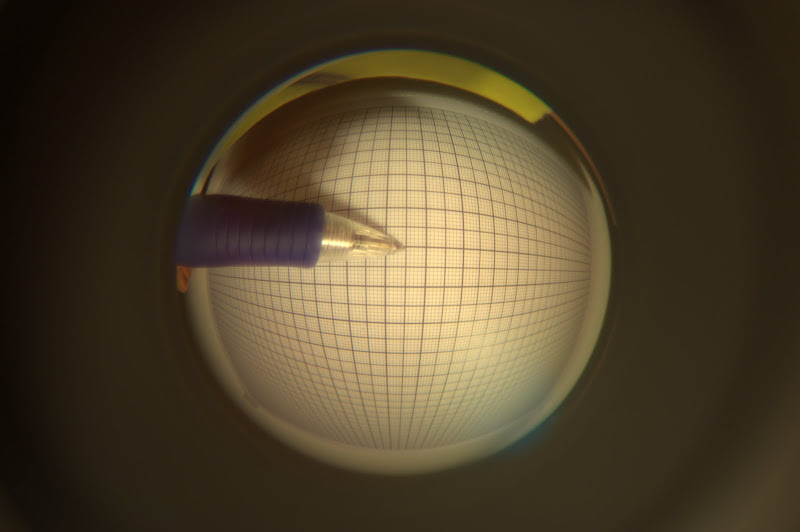
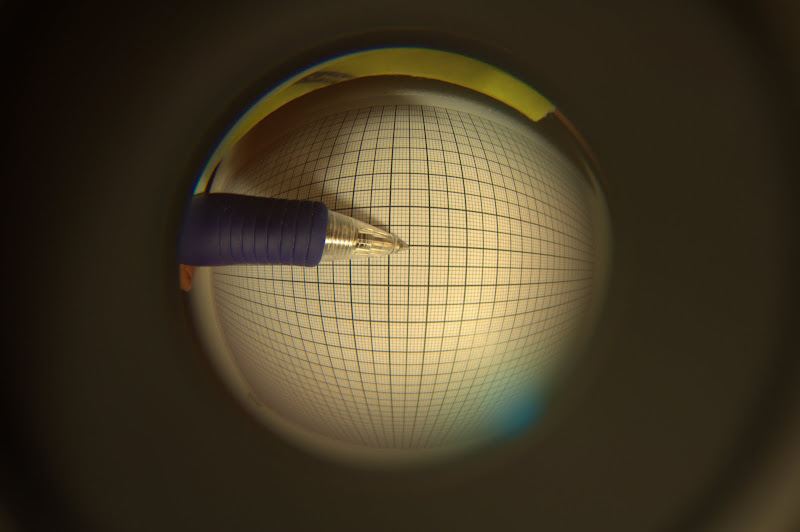

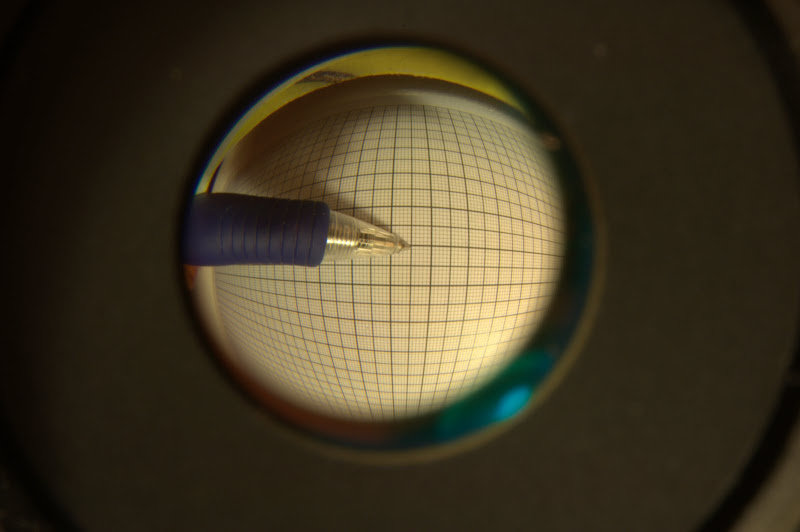
I guess one thing is that with the Tamron wide-open the thin DOF helps capture only the image projected by the fisheye, some 5mm behind its rear element; but when it is stopped down, the rear of the fisheye starts getting into focus (the deep focus is happening already inside the lens setup, hehe). The main problem seems to be vignetting caused by the Tamron's aperture closing (the edge of the projected image gets vignetted, and more of the rear of the fisheye gets visible instead). I tried with an additional circular-hole-in-cardboard stop in the open space between the lenses, but the impression is the stop should be inside the fisheye (infeasible unfortunately).
As much as I understand things, the suitable location for the aperture changes when combining lenses; and that it may happen that none of the two or three apertures available in the stack may be in a suitable position to allow stopping down considerably without vignetting?
Using the 20/3.5 reversed as relay, vignetting is much worse so the rear of the fisheye is not visible, and the circle narrows further when stopping down. But even in the sample above I guess I'm not getting the whole aerial image (image circle of the fisheye) - that its edge may be missing.
Here's the "Frazier" opposite example, with the 20/3.5 as the tip lens and the Tamron 60/2 macro at ca 1:1.5 magnification as the relay lens. The relayed image is only appearing directly behind the rear element... I guess it should be 35 mm wide, but in most of that space I'm only seeing the blurred rear of the lens.
20 mm view on a DX camera (D90)
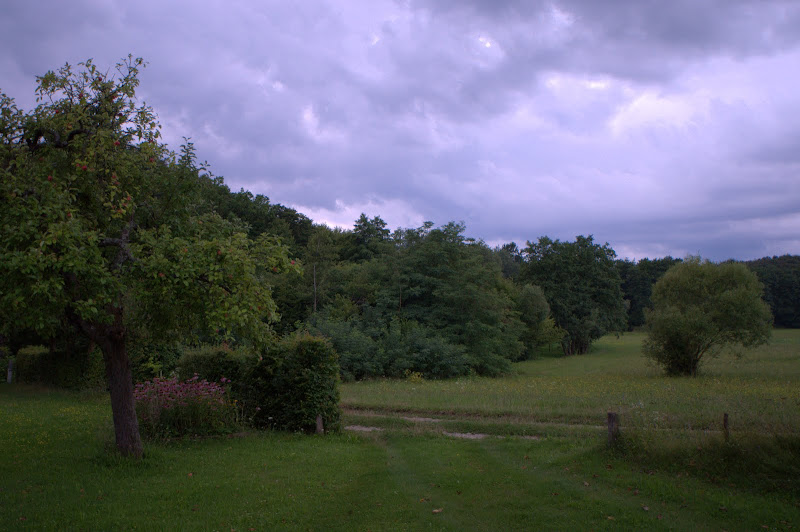
20mm via the relay macro lens
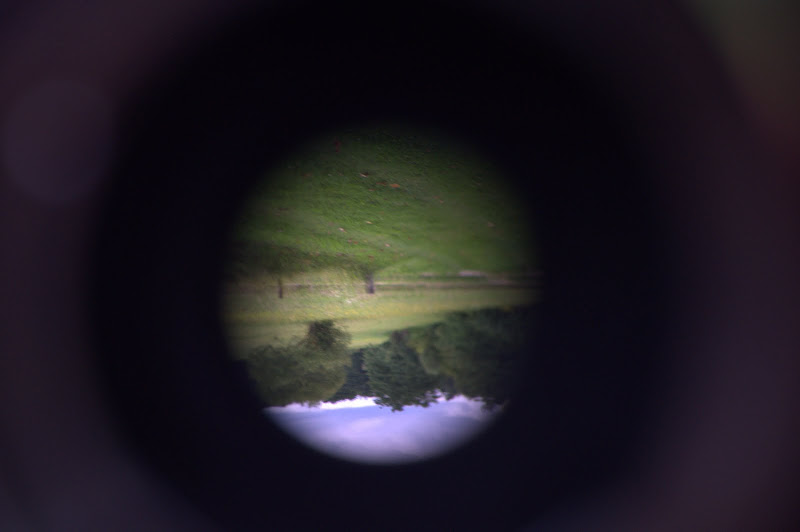
This actually looks quite good to me, what more were you hoping to get? A slight perpendicular misalignment seems to be the reason why top-left corner is sharper than bottom-right, and why you get some vignetting there when stopping down the Tamron._sem_ wrote:My best outcome so far with the Tamron 60 on extension tubes, magnification a bit over 2x (difficult to aim, I'd like some more). Notice this is a highly ad-hoc setup, no proper alignment, lightning, etc. The setup is open and some external light is hitting the rear of the CCTV fisheye, so you can also see the rear of the lens (best when stopped down), and the bluish blob is the reflection from the rear element. The test target is an A4 sheet of paper with mm grid, on a white wall, and a pen in front.
Sequence: F/4, F/8, F/16, F/32
I guess one thing is that with the Tamron wide-open the thin DOF helps capture only the image projected by the fisheye, some 5mm behind its rear element; but when it is stopped down, the rear of the fisheye starts getting into focus (the deep focus is happening already inside the lens setup, hehe). The main problem seems to be vignetting caused by the Tamron's aperture closing (the edge of the projected image gets vignetted, and more of the rear of the fisheye gets visible instead). I tried with an additional circular-hole-in-cardboard stop in the open space between the lenses, but the impression is the stop should be inside the fisheye (infeasible unfortunately).
As much as I understand things, the suitable location for the aperture changes when combining lenses; and that it may happen that none of the two or three apertures available in the stack may be in a suitable position to allow stopping down considerably without vignetting?
Does the fisheye really project a larger image than this? Try comparing the image of the fisheye alone, projected on paper f.i. with this result._sem_ wrote: Using the 20/3.5 reversed as relay, vignetting is much worse so the rear of the fisheye is not visible, and the circle narrows further when stopping down. But even in the sample above I guess I'm not getting the whole aerial image (image circle of the fisheye) - that its edge may be missing.
Mainly some more magnification for being able to aim properly; the level of vignetting wide-open is acceptable but the image is soft. As I stop down a notch the sharpness improves, but vignetting is worse; I'd like to be able to stop down beyond good taste for "deep focus" without ending in severe vignetting. And I'd prefer a more compact setup. And I'd like to know which of the other lens choices might work best.dickb wrote: This actually looks quite good to me, what more were you hoping to get?
Certain counterexamples (BR, Frazier etc) suggest that vignetting is not totally inevitable, though it does seem trial-and-error may be the only way (even if I had the knowledge I'd probably not have the required data for all these lenses).
Yes, I think the fisheye does project a bit larger image. The diameter of the part of the aerial image I get is about the same as that of the rear element of the fisheye that I see when I reduce the distance by 5mm (flange) EDIT: but should be almost twice that much. Though this angle is acceptable to me... if I could get it at a bit higher relay magnification.dickb wrote: Does the fisheye really project a larger image than this? Try comparing the image of the fisheye alone, projected on paper f.i. with this result.
I think I've got a new "high score", almost fills the frame. I'm not sure yet if it is actually vignetting decreased or just the visible part enlarged, got to check in better light. Relay recipe: Tamron 60 (close focus) on 20mm extension plus 20/3.5 reversed.
Tried also the 20/3.5 alone on extension... also better than without extension, though much more vignetting than with the Tamron.
So, what would you guys and gals say about the following candidate rules of thumb in case of relay vignetting
A: Insert an extension tube between the relay lens and the camera.
B: Get a relay lens with wider max aperture.
C: Get a tip lens with the rear lens diameter not much smaller than its image circle diameter.
Got another one?
Last edited by _sem_ on Mon Aug 08, 2011 12:09 am, edited 1 time in total.
Sorry I can't follow all your lens combinations  but you ask about vignetting.
but you ask about vignetting.
Isn't it just a question of measuring the image circle the front lens is producing, and magnifying it sufficiently to cover the sensor you're using?**
Say the front one gives 5mm diameter circle and your sensor is 23.6 x 15.8 so you need 28.4mm,
Call it 30mm. So you need 6x magnification.
The distance from the sensor to that will be 6 + 1 x the FL.
There are lots of cctv lenses on ebay with short focal lengths, 16mm seems to be common, so reversed should give you 6x, out 7 x 16 = 112mm from the sensor.
The lens to aerial image distance would be 18.6mm from the 16mm lens.
Those calculations will be a bit wrong because they use the "thin lens" model, but you get the idea.
If your image circle is smaller than that you'd probably be best off with a scope objective. There are many cheap ones which may ( or may not) introduce some CA. Or try the ones you have. Just search the Completed Listings on ebay for "10x Plan Objective" - you'll see some Nikon M Plans or BD Plans ( same with a collar for lighting)
** If that's wrong I'm way off, ignore me!
Isn't it just a question of measuring the image circle the front lens is producing, and magnifying it sufficiently to cover the sensor you're using?**
Say the front one gives 5mm diameter circle and your sensor is 23.6 x 15.8 so you need 28.4mm,
Call it 30mm. So you need 6x magnification.
The distance from the sensor to that will be 6 + 1 x the FL.
There are lots of cctv lenses on ebay with short focal lengths, 16mm seems to be common, so reversed should give you 6x, out 7 x 16 = 112mm from the sensor.
The lens to aerial image distance would be 18.6mm from the 16mm lens.
Those calculations will be a bit wrong because they use the "thin lens" model, but you get the idea.
If your image circle is smaller than that you'd probably be best off with a scope objective. There are many cheap ones which may ( or may not) introduce some CA. Or try the ones you have. Just search the Completed Listings on ebay for "10x Plan Objective" - you'll see some Nikon M Plans or BD Plans ( same with a collar for lighting)
** If that's wrong I'm way off, ignore me!
-
Harold Gough
- Posts: 5786
- Joined: Sun Mar 09, 2008 2:17 am
- Location: Reading, Berkshire, England
This is out of line with the situation with lenses in general photography. Stepping outside of macro*, with my X-Pan lenses, the wider the angle of the lens, the more need there is for measures (centre spot ND) to counter vignetting. The 90mm does not need it, the 45mm needs it when opened up wider than f8 and the 30mm needs it full time._sem wrote: the level of vignetting wide-open is acceptable but the image is soft. As I stop down a notch the sharpness improves, but vignetting is worse.
* The 90mm is being used for some macro, images being posted under various topics.
Your experience seem to support the small image circle suggestion from Chris.
Harold
My images are a medium for sharing some of my experiences: they are not me.

